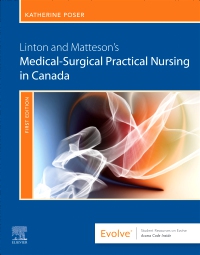
Linton and Matteson's Medical-Surgical Practical Nursing in Canada - Elsevier E-Book on VitalSource, 1st Edition
Elsevier eBook on VitalSource

Help your students master the role and responsibilities of the PN in Canadian medical-surgical nursing! The only Canadian medical-surgical nursing text designed for the Practical Nurse student, Linton and Matteson's Medical-Surgical Practical Nursing in Canada provides a solid foundation in the fundamentals of nursing, including roles, settings, and issues and trends in health care. Content includes descriptions of pathology, medical conditions organized by body system, emergency and disaster management, pandemic preparedness, and mental health nursing. Unique to this text is a unit focusing on the older adult — a key patient population that PNs see in practice. Featuring study tools to promote clinical reasoning and judgement, this text helps students prepare for the CPNRE® or REx-PN® licensure examinations and for success as new nurses.
-
- UNIQUE! Separate unit on gerontological nursing covers physiological and psychosocial changes in the older adult, along with common problems such as fall prevention, immobility, and incontinence
- Nursing care plans illustrate the application of content to the nursing process, with critical thinking questions to encourage thoughtful analysis of patient needs and nursing care
- Canada’s unique health care context and cultural landscape is reflected in content relating to race/ethnicity, Indigenous peoples, gender identity, 2SLGBTQI+ community, family composition, recent immigrants, refugees, and vulnerable persons
- Inclusion of Canadian statistics and research incorporates references and resources, Canadian nursing best practice guidelines, assessment and screening tools, protocols, and more
- Coverage of Canadian medications includes dosages and metric measurements
- Get Ready for Exams! section at the end of each chapter includes key points, additional learning resources, and PN competency review questions, addressing the latest Canadian PN competencies and helping to ensure student success on the REx-PN® or CPNRE®
- Study tools in the text and on the Evolve website encourage the development of clinical reasoning and judgement, helping students succeed on REx-PN® and CPNRE® licensure examinations
- Coverage of current Canadian issues and topics includes Bill C-14 Medical Assistance in Dying (MAiD), interprofessional collaboration, Indigenous health vis-à-vis the Truth and Reconciliation Commission findings and Calls to Action, pandemic planning and preparedness, and more
- Interprofessional Collaborative Care boxes highlight the team approach to patient care, helping nurses prioritize and safely assign tasks to other health professionals
- Patient Teaching plans provide bulleted lists of nursing instructions for patients, stressing the role and responsibility of the PN in patient education
- Cultural Considerations boxes discuss the needs of culturally diverse patients when planning nursing care
- Health Promotion Considerations boxes highlight timely wellness and disease prevention topics
- Put on Your Thinking Cap boxes allow students to pause and consider the practical implications of what they have just read
- Nutritional Considerations boxes emphasize the role nutrition plays in disease and holistic nursing care
- Complementary and Alternative Therapies boxes highlight nontraditional therapies along with precautions and possible side effects
- Key terms with phonetic pronunciations help improve the terminology and language skills of English-as-a-Second-Language (ESL) students and students with limited proficiency in English before they enter clinical practice
-
UNIT I: Medical-Surgical Nursing
1. Aspects of Medical-Surgical Nursing
2. Medical-Surgical Practice Settings
UNIT II: Populations Receiving Medical-Surgical Care
3. Medical-Surgical Patients: Individuals, Families, and Communities
UNIT III: Pathology Processes and Effects
4. Health, Illness, Stress, and Coping
5. Immunity, Inflammation, and Infection
6. Fluid, Electrolyte, and Acid-Base Balance
7. Cancer
8. Pain
9. Shock
UNIT IV: Special Problems of the Older Adult Patient
10. Older Persons
11. Falls
12. Immobility
13. Delirium & Dementia
14. Incontinence
UNIT V: Therapeutics
15. Nutrition
16. Intravenous Therapy
17. Surgery
18. The Patient With an Ostomy
19. Palliative and Hospice Care
20. Complementary and Alternative Therapies
UNIT VI: Neurological System
21. Neurological System Introduction
22. Neurological Conditions
23. Cerebrovascular Accident
24. Spinal Cord Injury
UNIT VII: Respiratory System
25. Respiratory System Introduction
26. Upper Respiratory Conditions
27. Acute Lower Respiratory Tract Conditions
28. Chronic Lower Respiratory Tract Conditions
UNIT VIII: Hematological and Immunological Systems
29. Hematological System Introduction
30. Hematological Conditions
31. Immunological System Introduction
32. Immunological Conditions
UNIT IX: Cardiovascular System
33. Cardiovascular System Introduction
34. Cardiac Conditions
35. Vascular Disorders
36. Hypertension
UNIT X: Digestive System
37. Digestive System Introduction
38. Upper Digestive Tract Conditions
39. Lower Digestive Tract Conditions
40. Liver, Gallbladder, and Pancreatic Conditions
UNIT XI: Urological System
41. Urological System Introduction
42. Urological Conditions
UNIT XII: Musculoskeletal System
43. Musculoskeletal System Introduction
44. Connective Tissue Conditions
45. Fractures
46. Amputations
UNIT XIII: Endocrine System
47. Endocrine System Introduction
48. Pituitary and Adrenal Conditions
49. Thyroid and Parathyroid Conditions
50. Diabetes and Hypoglycemia
UNIT XIV: Reproductive Systems
51. Female Reproductive System Introduction
52. Female Reproductive Conditions
53. Male Reproductive System Introduction
54. Male Reproductive Conditions
55. Sexually Transmitted Infections
UNIT XV: Integumentary Systems
56. Integumentary System Introduction
57. Skin Problems
UNIT XVI: Special Senses: Vision and Hearing
58. Special Senses Introduction
59. Eye and Vision Conditions
60. Ear and Hearing Conditions
UNIT XVII: Medical-Surgical Patients with Psychiatric Problems
61. Psychobiological Conditions
62. Substance Use
Unit XVIII: Nursing in Disasters and First Aid
63. First Aid, Emergency Care, and Disaster Management





 as described in our
as described in our 